Something that comes up from time to time, a key switch malfunctioning. Dirt grease and grime can cause shorting or lack of connection. Well, I was looking at the SG today and noticed the dirt all around the key switch. So here is the disassembly for cleaning a key switch. I will try to walk you through how it operates as well. Specifically the fork lock portion of the switch. The rest of it is pretty intuitive.
Note that the 78-79 models did not have hazard lights, and therefore had only three wires to the key switch, power form the main fuse (red wire), power to the fuse panel (tan wire) and power to the tail light fuse (blue wire). In 1980 Yamaha added the hazard switch and a red-yellow wire to the key switch. Power is always transferred to the red/yellow wire in any key position including off so the hazard lights work regardless of key position. In the ON position, power is also supplied to the tan and blue wires. When you turn the key to the PARK position, just past the LOCK position, power is transferred to the blue wire to light the tail light, but not the tan wire. This is an 80 switch so it is 4 wire.
Here we have the switch fully assembled. You can see the round hole where the 10mm bolts go that hold the switch to the top triple tree. You can also see the plunger that extends to lock the forks.
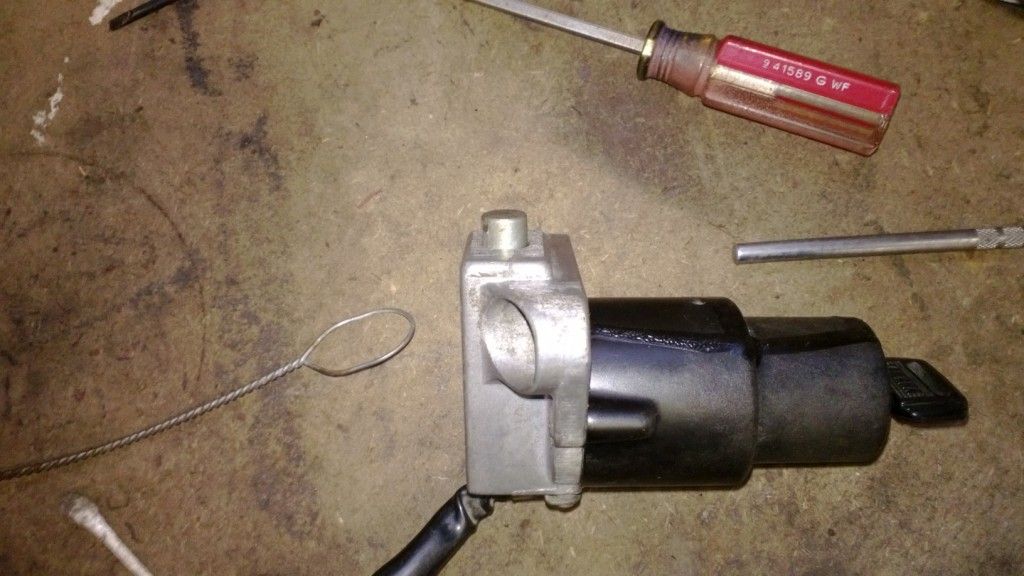
In this picture you see the two small screws that need to be removed to allow acces to the fork lock portion of the assembly. Note the plate also has a wire clip holding the harness to the switch.
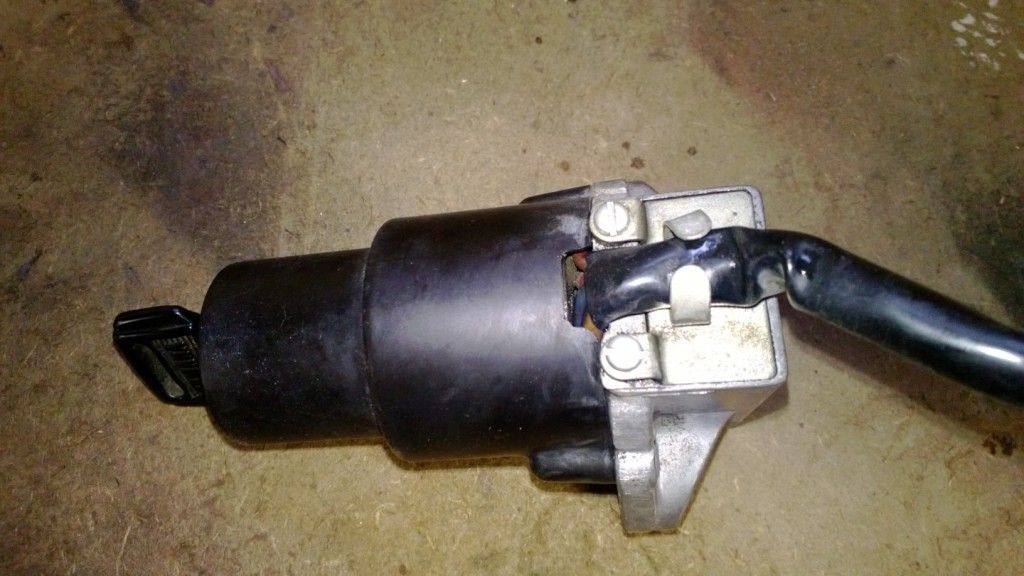
Once removed you can see the slide that moves to extend the fork lock plunger.

Now remove the two Phillips head screws, one can be seen in this picture. They hold the metal fork lock assembly to the plastic upper lock body. It also holds the electrical portion of the switch in place.
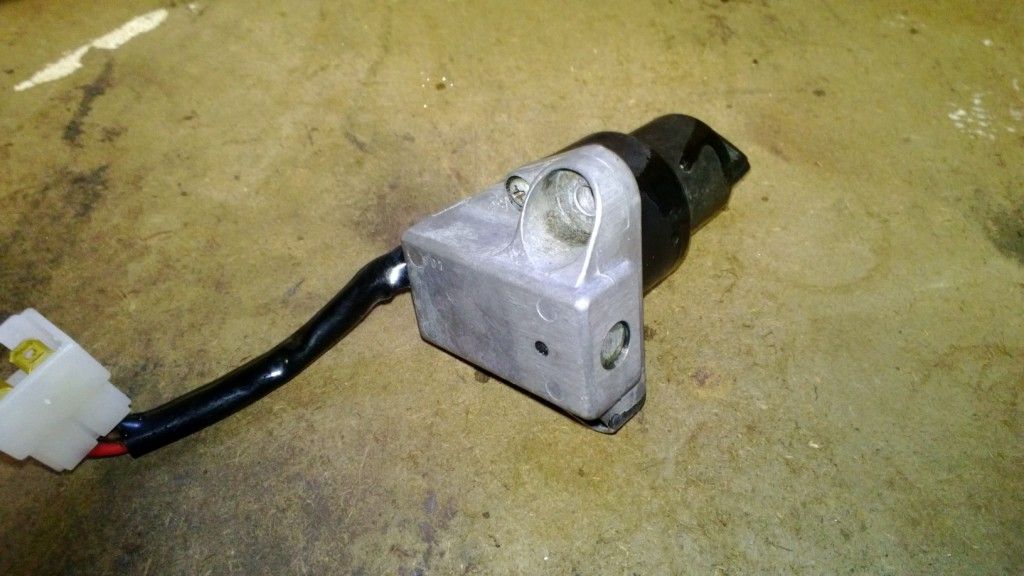 ]
]
Here you can see the two sections separated. Note the rotational position of the white plastic cam in the metal fork lock assembly. When you reassemble it you will want it on this same orientation.
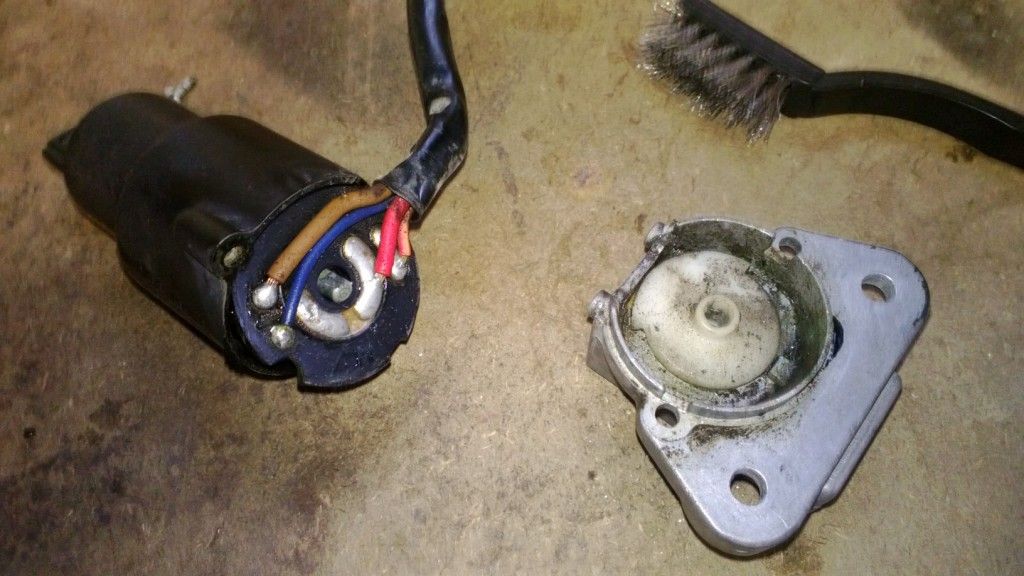
Holding the fork lock assembly, push in the metal slide from the back slightly, then lift out the white plastic cam. Now the slide and plunger will come out the back.
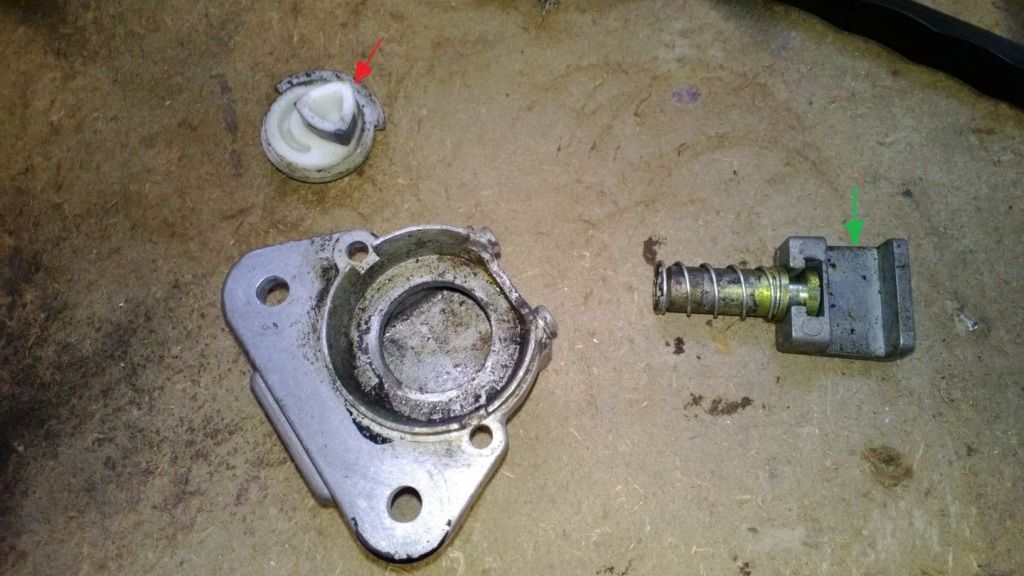
The cam (red arrow) fits in the slot of the slide (green arrow). When the cam is rotated it extends the plunger to lock into the notches in the down tube of the frame. All the pieces disassembled to be cleaned.

As you saw in an earlier picture, the wiring harness attaches to a plate with contactors. It simply slides out. There are tabs on the plastic body to help align the parts. Note in the picture the green arrows. Also note the red arrows for tabs that align the lower sections of the switch. Note the green arrow tabs are not 180 degrees from each other, and the red arrow tabs are different thickness. The parts have to be in the right orientation, as well as the correct side up to assemble the switch. Keep this in mind during re-assembly.
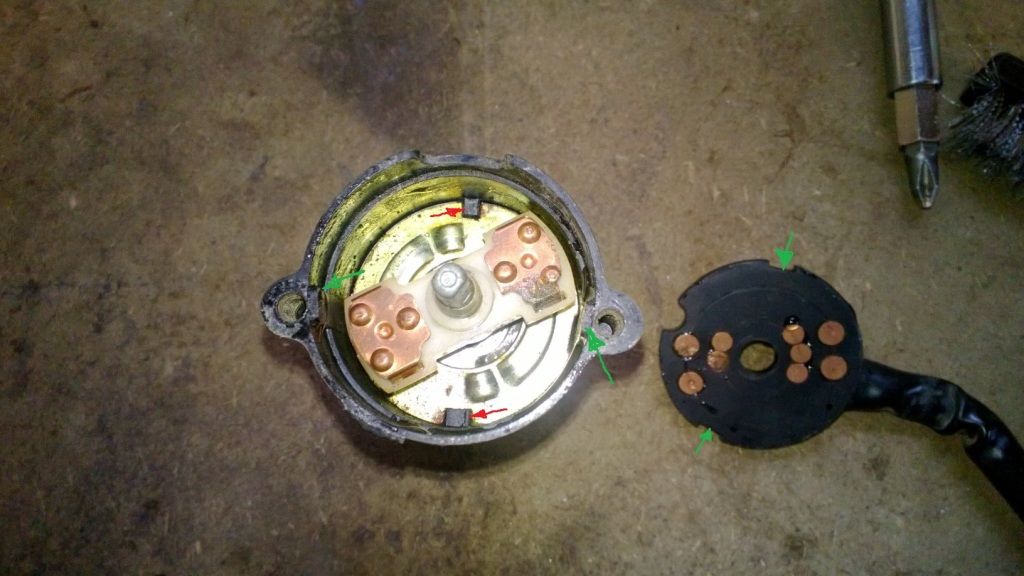
Now you can pull out the rotating contactor assembly that determines power direction as the key is turned. The shaft it rides on has flat sides. I use 600 grit sand paper to clean up the contactors. Thes have been burnt before.

Next the metal plate with the grooves for the contactor to ride in slides out. It will only go back in with the correct side up and turned the right direction.
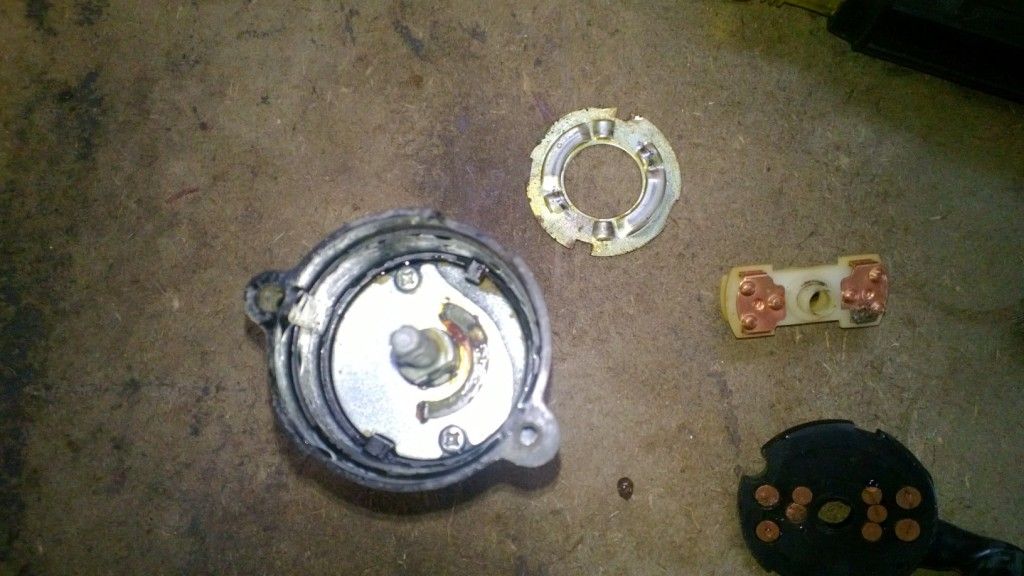
Next you will need to remove the two Phillips screws shown in the picture above. Then you can lift the switch shaft and its locating plate out. Note the switch shaft has a tab (red arrow) that rotates within the slot (red arrow) to limit its travel. Also not the different size slots in the locating plate making it impossible to install this in the wrong orientation. The spring is on the shaft of the tumbler assembly under the switch shaft.
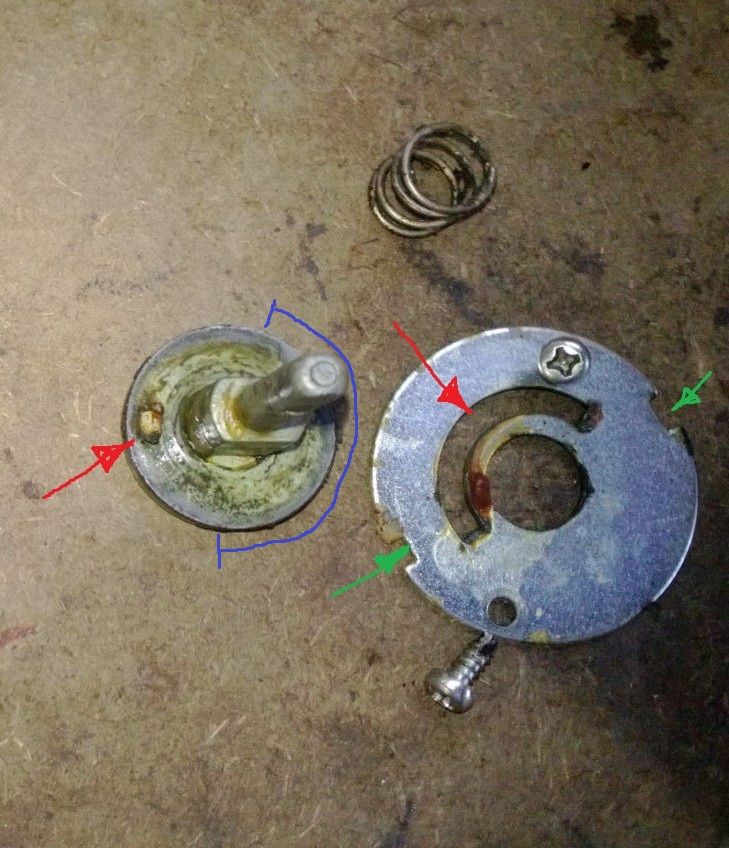
For purposes of understanding how the fork lock portion of the switch works, note the area of the switch shaft shown in blue. On the underside of that plate area there is a lip. That pushes against the plunger of another piece of the fork lock mechanism shown in this picture with the yellow arrow.
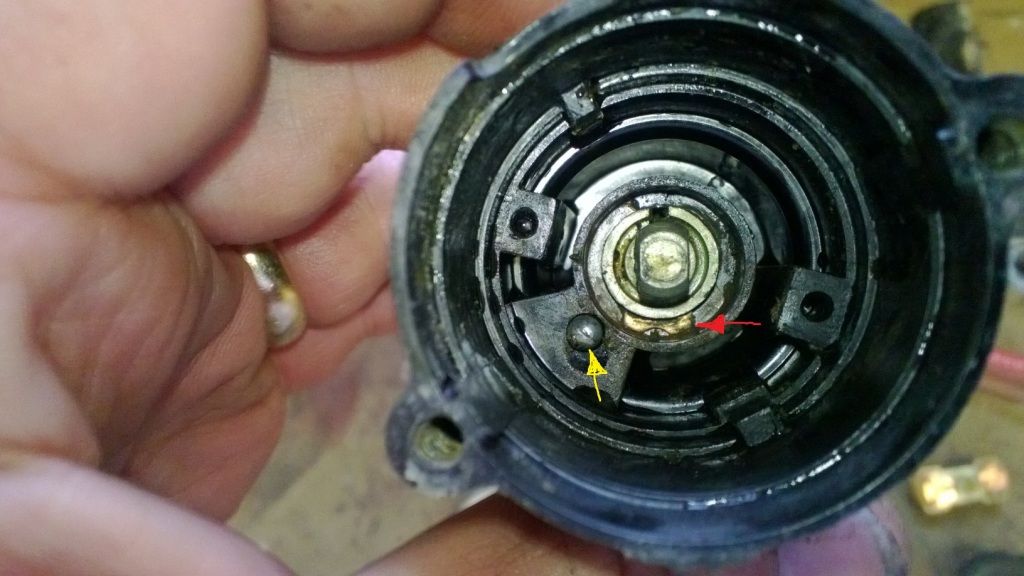
Note the red arrow in the above picture, this is the tab on the tumbler assembly that keep the cylinder from coming out of the housing. Before removing this, it is important to note that the small tabs that compose the keying of the lock are not locked in, they can fall out after you pull the cylinder from the housing. So use caution. Also make sure to note the postion of the tab relative to the housing, it has to go back in this orientation. Use a small screwdriver to push the tab into the cylinder, and you can push the cylinder out of the housing. Here is the cylinder after removal. Another red arrow to indicate that tab that holds it in the housing.
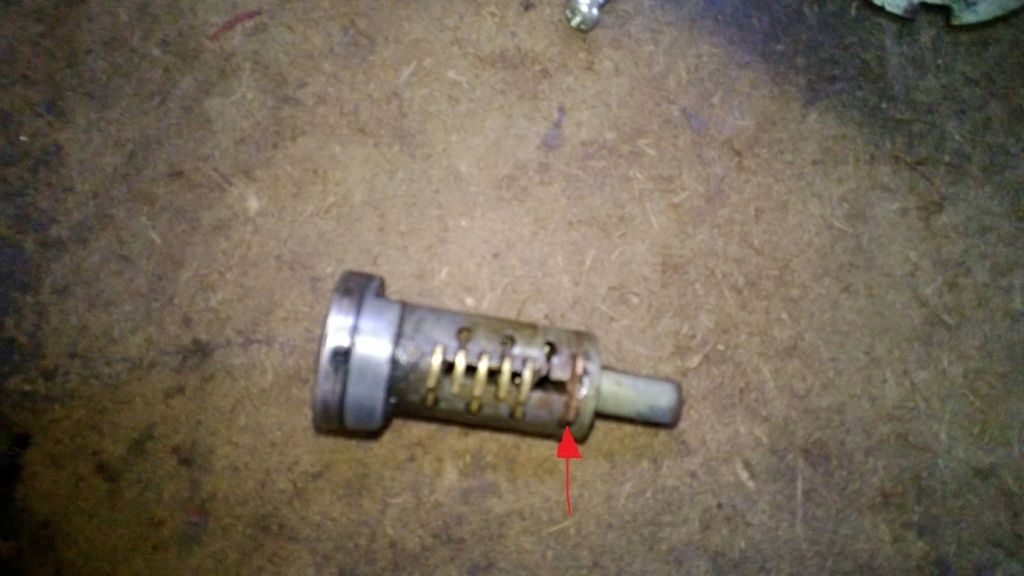
For those of you that may not be familiar with how a lock cylinder works, the rest of the tabs you see are specifically sized to match the key for the lock. So if any fall out, they have to go back in the same spot or your key will no longer work that lock.
Now you have an almost empty housing. Remember that fork lock plunger piece, it can now be pushed out. But again, care must be taken. There is a small spring and pad in the side of this slide, on the side that faces the exterior of the housing. When you get it past the housing body, it can fly out and travel to parts unknown of your shop. DAMHIKIJK So watch for it and keep it contained. The slide (green arrow) comes out the top of the housing, push it out with a jewelers screwdriver or similar object through the round hole.
So watch for it and keep it contained. The slide (green arrow) comes out the top of the housing, push it out with a jewelers screwdriver or similar object through the round hole.
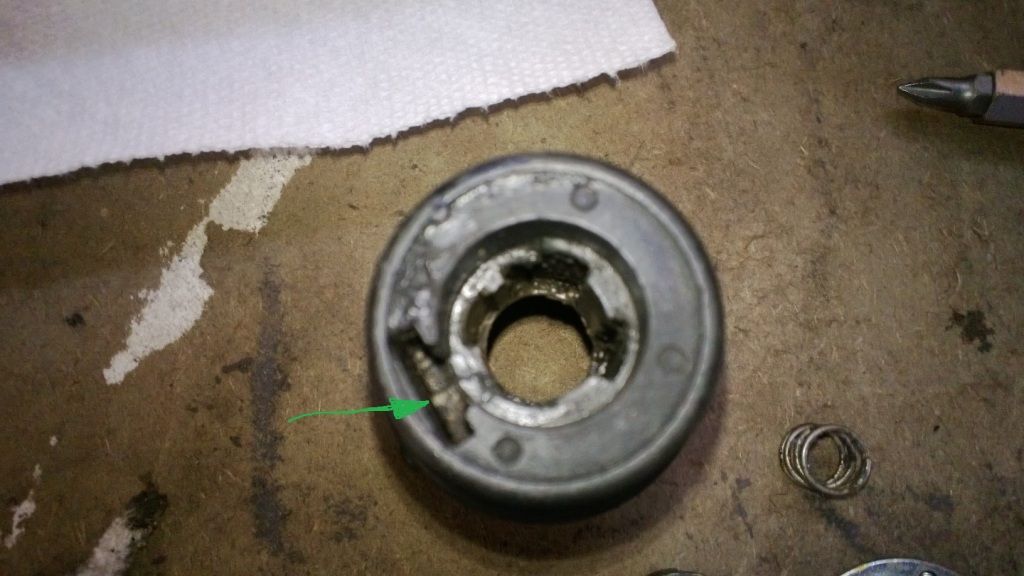
So you can see the shape of the top of the plunger. This is what stops the switch from rotating to the fork lock and park positions. You can also see the hole the spring and small button go into. Remember this faces the exterior of the housing when re-assembling.
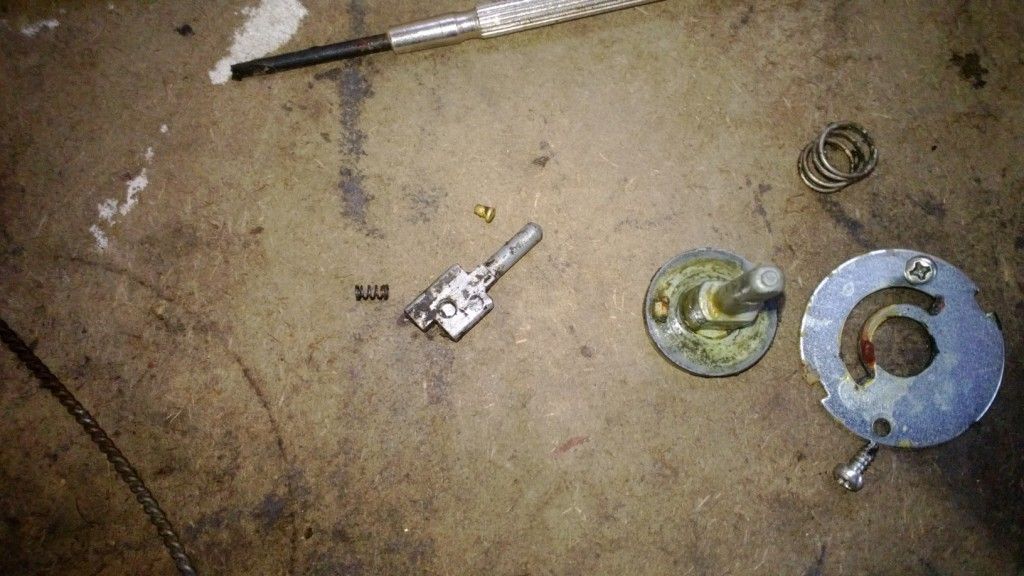
Now to explain the fork lock operation. If you look at the lock cylinder, you will notice the under side of the upper rim has a step in it. We also noted the thicker lip area of the switch shaft plate. When you turn the key from OFF toward the fork lock, that step in the cylinder will hit the raised plunger that is pushed up by that lip on the switch shaft plate. When you turn the cylinder till it hits that plunger, the switch shaft plate is rotated so the thinner area is over the fork lock plunger. When you push the cylinder into the housing, it pushes the plunger down, and it stays down. This lets the key switch rotate past it to the lock and or parking positions. When you turn the key back, the lip under the switch shaft plate pushes that plunger back up to so the key can not turn past off position. Also, the cam in the lower fork lock assembly does not get turned to extend the plunger until the shaft is turned past the off position to the lock position. Hope that helps clarify how that works.
I do not like to use lubricant in the key switch assembly. Maybe a little graphite in spray form in the cylinder after it is assembled. Oil and grease in the rest of it will only attract dirt and debris.
Hope this helps someone who may need to clean their key switch assembly but not know how to get it apart. It is not terribly complicated.
Note that the 78-79 models did not have hazard lights, and therefore had only three wires to the key switch, power form the main fuse (red wire), power to the fuse panel (tan wire) and power to the tail light fuse (blue wire). In 1980 Yamaha added the hazard switch and a red-yellow wire to the key switch. Power is always transferred to the red/yellow wire in any key position including off so the hazard lights work regardless of key position. In the ON position, power is also supplied to the tan and blue wires. When you turn the key to the PARK position, just past the LOCK position, power is transferred to the blue wire to light the tail light, but not the tan wire. This is an 80 switch so it is 4 wire.
Here we have the switch fully assembled. You can see the round hole where the 10mm bolts go that hold the switch to the top triple tree. You can also see the plunger that extends to lock the forks.

In this picture you see the two small screws that need to be removed to allow acces to the fork lock portion of the assembly. Note the plate also has a wire clip holding the harness to the switch.

Once removed you can see the slide that moves to extend the fork lock plunger.

Now remove the two Phillips head screws, one can be seen in this picture. They hold the metal fork lock assembly to the plastic upper lock body. It also holds the electrical portion of the switch in place.
 ]
]Here you can see the two sections separated. Note the rotational position of the white plastic cam in the metal fork lock assembly. When you reassemble it you will want it on this same orientation.

Holding the fork lock assembly, push in the metal slide from the back slightly, then lift out the white plastic cam. Now the slide and plunger will come out the back.

The cam (red arrow) fits in the slot of the slide (green arrow). When the cam is rotated it extends the plunger to lock into the notches in the down tube of the frame. All the pieces disassembled to be cleaned.

As you saw in an earlier picture, the wiring harness attaches to a plate with contactors. It simply slides out. There are tabs on the plastic body to help align the parts. Note in the picture the green arrows. Also note the red arrows for tabs that align the lower sections of the switch. Note the green arrow tabs are not 180 degrees from each other, and the red arrow tabs are different thickness. The parts have to be in the right orientation, as well as the correct side up to assemble the switch. Keep this in mind during re-assembly.

Now you can pull out the rotating contactor assembly that determines power direction as the key is turned. The shaft it rides on has flat sides. I use 600 grit sand paper to clean up the contactors. Thes have been burnt before.

Next the metal plate with the grooves for the contactor to ride in slides out. It will only go back in with the correct side up and turned the right direction.

Next you will need to remove the two Phillips screws shown in the picture above. Then you can lift the switch shaft and its locating plate out. Note the switch shaft has a tab (red arrow) that rotates within the slot (red arrow) to limit its travel. Also not the different size slots in the locating plate making it impossible to install this in the wrong orientation. The spring is on the shaft of the tumbler assembly under the switch shaft.

For purposes of understanding how the fork lock portion of the switch works, note the area of the switch shaft shown in blue. On the underside of that plate area there is a lip. That pushes against the plunger of another piece of the fork lock mechanism shown in this picture with the yellow arrow.

Note the red arrow in the above picture, this is the tab on the tumbler assembly that keep the cylinder from coming out of the housing. Before removing this, it is important to note that the small tabs that compose the keying of the lock are not locked in, they can fall out after you pull the cylinder from the housing. So use caution. Also make sure to note the postion of the tab relative to the housing, it has to go back in this orientation. Use a small screwdriver to push the tab into the cylinder, and you can push the cylinder out of the housing. Here is the cylinder after removal. Another red arrow to indicate that tab that holds it in the housing.

For those of you that may not be familiar with how a lock cylinder works, the rest of the tabs you see are specifically sized to match the key for the lock. So if any fall out, they have to go back in the same spot or your key will no longer work that lock.
Now you have an almost empty housing. Remember that fork lock plunger piece, it can now be pushed out. But again, care must be taken. There is a small spring and pad in the side of this slide, on the side that faces the exterior of the housing. When you get it past the housing body, it can fly out and travel to parts unknown of your shop. DAMHIKIJK
 So watch for it and keep it contained. The slide (green arrow) comes out the top of the housing, push it out with a jewelers screwdriver or similar object through the round hole.
So watch for it and keep it contained. The slide (green arrow) comes out the top of the housing, push it out with a jewelers screwdriver or similar object through the round hole.
So you can see the shape of the top of the plunger. This is what stops the switch from rotating to the fork lock and park positions. You can also see the hole the spring and small button go into. Remember this faces the exterior of the housing when re-assembling.

Now to explain the fork lock operation. If you look at the lock cylinder, you will notice the under side of the upper rim has a step in it. We also noted the thicker lip area of the switch shaft plate. When you turn the key from OFF toward the fork lock, that step in the cylinder will hit the raised plunger that is pushed up by that lip on the switch shaft plate. When you turn the cylinder till it hits that plunger, the switch shaft plate is rotated so the thinner area is over the fork lock plunger. When you push the cylinder into the housing, it pushes the plunger down, and it stays down. This lets the key switch rotate past it to the lock and or parking positions. When you turn the key back, the lip under the switch shaft plate pushes that plunger back up to so the key can not turn past off position. Also, the cam in the lower fork lock assembly does not get turned to extend the plunger until the shaft is turned past the off position to the lock position. Hope that helps clarify how that works.
I do not like to use lubricant in the key switch assembly. Maybe a little graphite in spray form in the cylinder after it is assembled. Oil and grease in the rest of it will only attract dirt and debris.
Hope this helps someone who may need to clean their key switch assembly but not know how to get it apart. It is not terribly complicated.




 ), much less a thief!....
), much less a thief!....
Comment